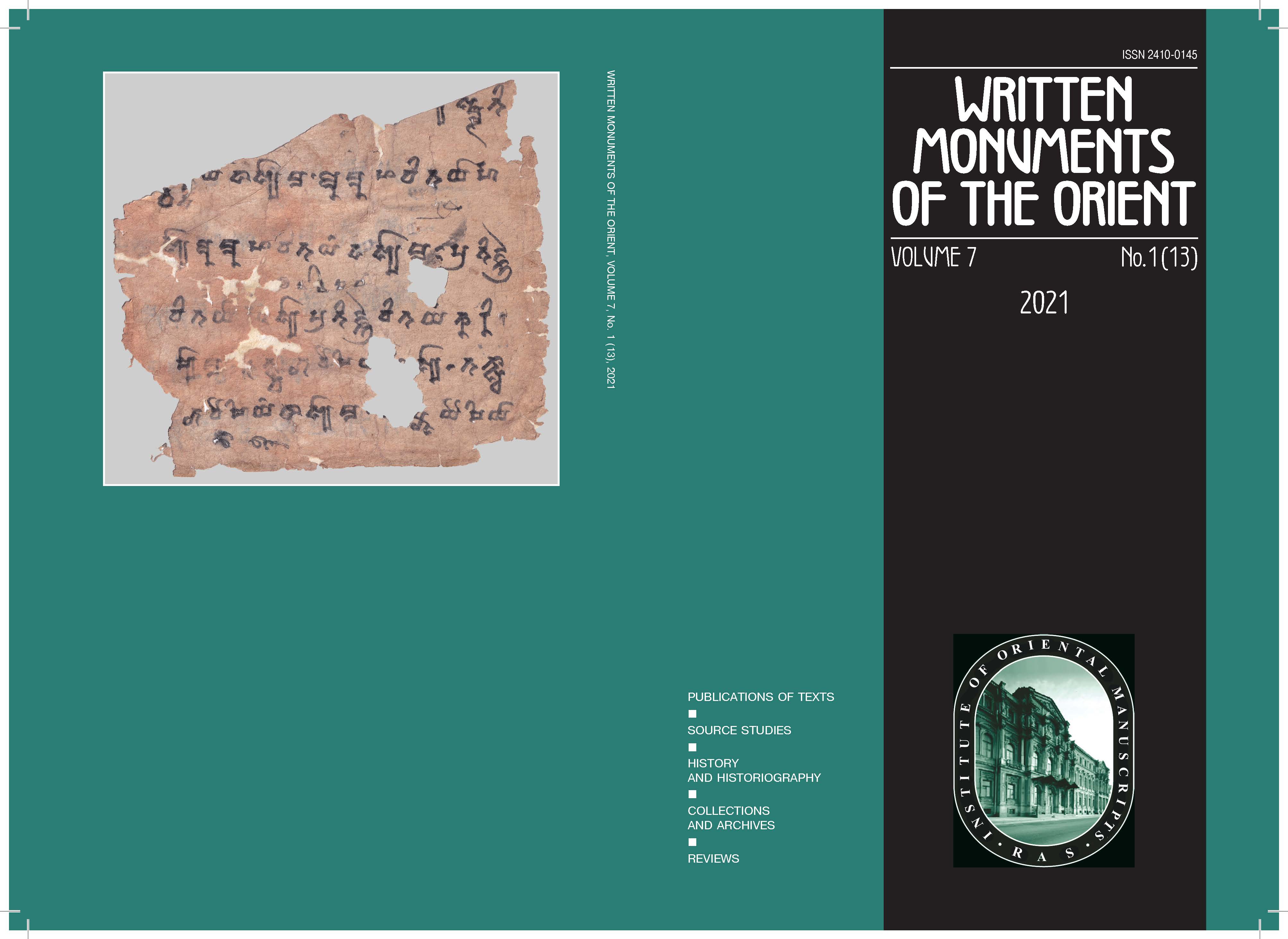卷 7, 编号 1 (2021)
- 年: 2021
- ##issue.datePublished##: 21.12.2021
- 文章: 4
- URL: https://journals.eco-vector.com/2410-0145/issue/view/3345
- DOI: https://doi.org/10.17816/wmo.71
完整期次
Original Papers
Miscellanea in the Brāhmī Script from the Berezovsky and Krotkov Collections (IOM, RAS) with an Appendix: ВФ-4190
摘要
The main part of this article provides a complete edition (description, transliteration, transcription, preliminary translation, annotation as well as the reproduction of the photographs) of forty-two fragments in different languages, circulated along the northern Silk Road, today in the territory of modern Xinjiang Uighur Autonomous Region (PR China) in pre-Mongolian times: Sanskrit, Tocharian A/B, Old Uyghur [hereafter: Uyghur]. Their common feature is the use of the standard North Turkestan Brāhmī and its Tocharian and Uyghur varieties. In terms of content, the fragments include extracts from Buddhist texts such as Abhidharmadīpavibhāṣaprabhāvr̥tti, Prajñāpāramitā, Prasādapratibhodbhava, Prātimokṣasūtra, Pravāraṇasūtra, Saṃyuktāgama, Suvarṇabhāsottamasūtra, Udānavarga. There are also some Tocharian B document fragments. Several of these texts are found on the back of Chinese scrolls. The Chinese texts have been identified. Where possible, a reconstruction of the relevant section of the scroll has been added. An introduction provides general background information. The lexis of the edited manuscripts is given in concordances.
 3-70
3-70


An Old Uyghur Translation of the 開蒙要訓 Kaimeng yaoxun
摘要
The verso of a scroll of the Old Uyghur version of the Säkiz yükmäk yaruk sudur contains an Old Uyghur translation of the Kaimeng yaoxun 開蒙要訓, a textbook for learning Chinese which is known from the Dunhuang finds only. The Uyghur fragments of this version are preserved in the Serindia Collection of the Institute of Oriental Manuscripts of the Russian Academy of Sciences as well as in the Turfan Collection of the Berlin Brandenburg Academy of Sciences and Humanities. In this paper one section is given in transliteration, transcription and in translation based on the Chinese Vorlage.
 71-99
71-99


Old Uyghur Sitātapatrā Dhāraṇī Fragments Preserved in the State Hermitage Museum
摘要
Due to the publication of Nikolai Pchelin and Simone-Christiane Raschmann “Turfan manuscripts in the State Hermitage — a rediscovery” published in 2016, it became obvious that some manuscript and blockprint fragments in different languages used in Central Asia, that had been discovered in the course of four German Turfan expeditions (1902–1914) and later housed in the Museum für Völkerkunde (Berlin) for exhibition reasons, nowadays are preserved in the depot of the State Hermitage Museum. The present article deals with two Old Uyghur fragments of Sitātapatrā dhāraṇī blockprinted during the Yuan era. This paper presents codicological description of the fragments, and transcription, transliteration, translation and facsimiles of the preserved parts of the text.
 100-117
100-117


Letters from Stanislas Aignan Julien (1797–1873) to Baron Paul Ludwig von Canstadt (1786–1837)
摘要
Julien was one of the outstanding Sinologists while Schilling von Canstadt is known as an inventor, as an Orientalist, a printer, and a bibliophile. The latter assembled a great many rare books in Chinese, Manchu, Mongol and Tibetan which later enriched the collections of the Russian Academy of Sciences. As a printer he mastered the intricacies of handling Oriental scripts by means of lithography and paved the way for cost effective and aesthetically satisfactory Oriental printing in Europe. The following letters, so far unpublished, give an insight into the relationship of the two scholars.
 118-135
118-135











